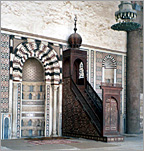by Laura Shefler, Instructor

 s the call to prayer echoed within the walls, a hand-held camera glided down one aisle of the great hall of the Umayyad Mosque of Damascus, then panned left, revealing key features of Islamic architecture: the ornately carved marble pulpit, known as a minbar, and a tiled mihrab, one the niches in the southern wall that indicates the direction of Mecca. These images were from a series of YouTube videos we viewed last summer our ATDP AP Art History class last summer. As we watched, we noted the Corinthian columns—ruins from Roman-era temple of Jupiter that were repurposed in the 8th century to create a new place for Muslims to gather and pray.
s the call to prayer echoed within the walls, a hand-held camera glided down one aisle of the great hall of the Umayyad Mosque of Damascus, then panned left, revealing key features of Islamic architecture: the ornately carved marble pulpit, known as a minbar, and a tiled mihrab, one the niches in the southern wall that indicates the direction of Mecca. These images were from a series of YouTube videos we viewed last summer our ATDP AP Art History class last summer. As we watched, we noted the Corinthian columns—ruins from Roman-era temple of Jupiter that were repurposed in the 8th century to create a new place for Muslims to gather and pray. At the same time, we could see more than just the architecture. Two older men sat crossed legged at the foot of the minbar, conversing. Other men, and a few women as well, all in heavy robes and head coverings, bowed in front of the mihrab. Outside in the courtyard the camera focused an octagonal structure, covered in magnificent green and gold mosaics. This structure was once the storehouse for all the wealth of the community. Now, young children chased one another around and under its supporting columns. People of all ages strolled barefoot in the sunlight over the spotless, gleaming marble floor. We could have learned about this mosque from a textbook, but the resources of the internet offered us even more: the chance to look through the eyes of visitors, to see how people today interact with the architecture, and perhaps to gain insight not just into the floor plan but also into the life of this 1200-year-old place of worship.When you are learning about art, there’s no substitute for a first-hand experience. You can study the graceful lines of a Byzantine icon in a photographic reproduction, but it’s even better to see it in a church, where the flames of votive candles reflect in the gold-leaf that lines the Virgin Mary’s dress. All the same, today’s students of art history have learning opportunities that no other generation has experienced, opportunities made possible by the continuing growth of the Web.
At the same time, we could see more than just the architecture. Two older men sat crossed legged at the foot of the minbar, conversing. Other men, and a few women as well, all in heavy robes and head coverings, bowed in front of the mihrab. Outside in the courtyard the camera focused an octagonal structure, covered in magnificent green and gold mosaics. This structure was once the storehouse for all the wealth of the community. Now, young children chased one another around and under its supporting columns. People of all ages strolled barefoot in the sunlight over the spotless, gleaming marble floor. We could have learned about this mosque from a textbook, but the resources of the internet offered us even more: the chance to look through the eyes of visitors, to see how people today interact with the architecture, and perhaps to gain insight not just into the floor plan but also into the life of this 1200-year-old place of worship.When you are learning about art, there’s no substitute for a first-hand experience. You can study the graceful lines of a Byzantine icon in a photographic reproduction, but it’s even better to see it in a church, where the flames of votive candles reflect in the gold-leaf that lines the Virgin Mary’s dress. All the same, today’s students of art history have learning opportunities that no other generation has experienced, opportunities made possible by the continuing growth of the Web.
Later in the summer, we began using the web to study European art. Working with the Web Gallery of Art, an online catalog of artwork from the late medieval period through the mid 19th century, we used the zoom function to zero in on the giant strawberries, sword-wielding mice, and other surreal details of Bosch’s Garden of Earthly Delights. With their peers following along on screen, students gave lectures comparing and contrasting different paintings on the similar themes. One student, for instance, drew everyone’s attention to the rough river bank where Mary, Joseph, and Jesus led their mule in Caracci’s Flight into Egypt. She contrasted this unsheltering landscape with the leafy bower in Caravaggio’s Rest on the Flight into Egypt, where an angel played violin music for this same group travelers. How could one story produce two such different paintings? The class discussed the question at length.An outstanding source of images, the web is also sometimes a valuable source of information about art. For in-depth research projects, I always insist that students go to the library and unearth those ancient artifacts known as “books.” Nevertheless, the web can be a great starting place for learning about modern and contemporary art movements. When a classmate posted discussion question on our class web site about the pop art movement—”Would a pop artist consider a regular soup can as beautiful as one remade by an artist? Is the beauty in the idea or the artwork?”—students dug around for commentary from scholars of pop art on the “transformation from everyday object to fine art manifestation.” They also cited the statements of the original soup-can painter, Andy Warhol. One student quoted Warhol as saying, “I like boring things.” The student went on to argue that the soup, boring though it might be in and of itself, could represent almost a “logo of American society” and to conclude that “Warhol would probably say that the idea holds the beauty.”
 Over the course of the summer, the conversations on our class website became an increasingly important aspect of our course. After a presentation on Donatello’s statue of Saint George, students wrote comments debating artist’s intentions. When someone argued that Donatello’s statue of Saint George showed the power of concentration in the dragon-fighter’s face, another replied, “I actually didn’t see concentration and might in Donatello’s St. George. I thought the widened eyes looked like fear, and the subtle wrinkled brow resembled confusion.” A third student agreed, in part, with this assessment, “except I found the wrinkles to give more of a concerned look … than a confused one.” A fourth weighed in: “…but it’s hard to tell the difference sometimes whether someone is lost or just thinking really hard.”
Over the course of the summer, the conversations on our class website became an increasingly important aspect of our course. After a presentation on Donatello’s statue of Saint George, students wrote comments debating artist’s intentions. When someone argued that Donatello’s statue of Saint George showed the power of concentration in the dragon-fighter’s face, another replied, “I actually didn’t see concentration and might in Donatello’s St. George. I thought the widened eyes looked like fear, and the subtle wrinkled brow resembled confusion.” A third student agreed, in part, with this assessment, “except I found the wrinkles to give more of a concerned look … than a confused one.” A fourth weighed in: “…but it’s hard to tell the difference sometimes whether someone is lost or just thinking really hard.”
Although the web may be a symbol of the fast-paced information age, this was an occasion when the internet actually enabled us to slow down. In this activity, where students wrote about a sculpture while they all looked at it on screen, they spent more time than usual examining the artwork, more time than they would have spent looking at a picture in a book. Their online conversation pushed them to think hard about what they were seeing, reconsidering their first impressions in light of the ideas of their peers. They responded thoughtfully, remaining open to multiple viewpoints rather than trying to push for a single answer to the debate. Used wisely, the web can provide students of art history not just with food for thought, but with a feast.
Laura Shefler is a long-time ATDP instructor as well as a former staffer.
Links to her gorgeous artwork can be found here:
